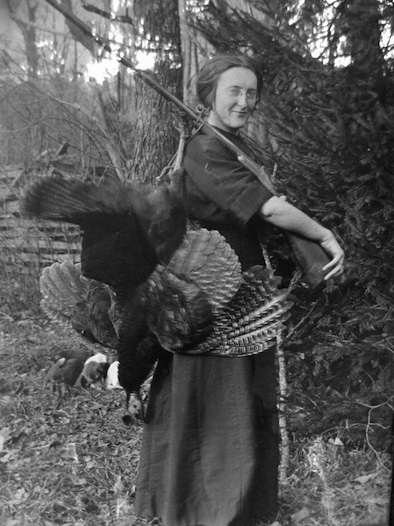Over the years, I’ve published a number of turkey roasting approaches and have settled on two that I love. One is based on Alice Waters’classic brining technique, which involves some serious logistics — finding a vessel big enough for the bird, and then a spot chill and big enough to store it while it sits in the brine — and produces terrific results. Many friends have taken the basic recipe, below, and improvised on the flavorings added to the essential salt/water formula.
The second approach, and the one I’ll do for my simplified Thanksgiving this year, was pioneered by chef Judy Rogers of Zuni Cafe. We posted about it in detail last year. She simply salts the bird well in advance, a method we use for just about any meat or poultry we cook (if we have the time). The salt has time to penetrate the flesh, seasoning and tenderizing it all the way through. It’s much easier to manage than wet-brining and produces delicious, if not quite as sensational results.
So here are both recipes rounded up in one place, so you can plan your Thanksgiving strategy.

Recipe: Pre-Salted, Dry-Brined Roast Turkey (adapted from the great Canal House Cooks Every Day)
My rule of thumb for salting meat or poultry: figure a scant 3/4 teaspoon kosher salt per pound, less if using sea salt.
Rinse a 14–16-pound fresh turkey (not injected or pre-brined) and pat dry with paper towels. Rub or pat 3 tablespoons kosher salt onto the breasts, legs, and thighs. Tightly wrap the turkey completely in plastic wrap or slip it into a very large resealable plastic bag, pressing out the air before sealing it. Set the turkey on a pan breast side up and refrigerate it for 3 days. Turn the turkey every day, massaging the salt into the skin through the plastic.
Unwrap the turkey and pat it dry with paper towels (don’t rinse the bird). Return the turkey to the pan breast side up and refrigerate it, uncovered, for at least 8 hours or overnight.
Remove the turkey from the refrigerator and let it come to room temperature, at least 1 hour. Preheat the oven to 325°.
If you’ve decided to serve your turkey stuffed, spoon the stuffing of your choice into the cavity of the bird. (Put any extra stuffing into a buttered baking dish, cover, and put it in the oven to bake with the turkey for the last hour.) Tie the legs together with kitchen string. Tuck the wings under the back. Rub the turkey all over with 3–4 tablespoons softened butter.
Place the turkey breast side up on a roasting rack set into a large roasting pan. Add 2 cups water to the pan. Roast the turkey until it is golden brown and a thermometer inserted into the thigh registers 165°, about 3 hours for an unstuffed bird and 3–4 hours for a stuffed one.
Transfer the turkey to a platter, loosely cover it with foil, and let it rest for 20–30 minutes before carving. Serve the turkey and stuffing, if using, with the pan drippings.
Recipe: Foolproof Roast Turkey Recipe (from A New Way to Cook)
You’ll find more detailed strategies for wet-brining a big bird here.
You may make the brine up to 2 days ahead; cover and refrigerate. If you wish, you can stuff the bird before roasting it; tie the legs together and roast the bird about 20 minutes longer.
Note: the water, salt and sugar are the essentials of a brine…you can improvise the flavorings at will
Aromatic Brine
2 gallons water
3/4 cup plus 2 tablespoons kosher salt
3/4 cup sugar
2 medium onions, peeled and coarsely chopped
1 carrot, peeled and coarsely chopped
1 celery branch, peeled and coarsely chopped
1 leek, white and light green parts only, cleaned and coarsely chopped
3 to 4 sprigs fresh thyme
2 bay leaves
1 tablespoon black peppercorns
1 tablespoon coriander seeds
1/4 teaspoon fennel seeds
1/4 teaspoon red pepper flakes
2 star anise (optional)
One 12 to 14 pound organic, free-range turkey, giblets, liver and neck reserved for broth*
1 tablespoon extra-virgin olive oil
6 large rosemary branches tied together and the cut end to make a brush for basting (optional)
To make the brine: In a large stockpot, bring 1 gallon of water to a boil. Stir in the salt and sugar until completely dissolved.Turn off the heat and add the onion, carrot celery, leek, thyme, bay leaves, peppercorns, coriander and fennel seeds, red pepper flakes, star anise and/or any other flavorings you wish. Stir in 1 gallon cold water. Let the brine cool completely, then refrigerate until cold.
Rinse the turkey inside and out with cold water. Carefully place the turkey in the brine. To keep the turkey submerged below the surface of the brine, place a weight on top of the bird such as a heavy plate or pot lid. Refrigerate 24 to 72 hours (longer is better).
Remove the turkey from the brine and pat dry. Place the turkey on a rack in a large roasting pan and rub all over with olive oil. Let sit 1 hour to come to room temperature.
Preheat the oven to 425’F. Roast until the turkey starts to brown, about 25 minutes. Turn the oven down to 350’F and roast about 10 minutes per pound, until the an instant-read thermometer inserted in the thickest part of the thigh reads about 160 degrees about 2 to 2 1/2 hours. As the turkey roasts, use the rosemary branch brush to baste it frequently with the pan juices. If the bird begins to darken too much, cover loosely with foil.
Remove the turkey from the oven, transfer to a serving platter and let rest 20 minutes before carving.
*Because the roasted turkey juices will be quite salted from the brine, we recommend pouring them off, skimming off the fat and mixing them with unsalted turkey broth to make a pan sauce. To make a turkey broth, up to the two day’s before, simmer the turkey giblets and neck in about 2 cups unsalted chicken broth for 1/2 hour; then strain and refrigerate until needed.
To make a pan sauce, pour off the juices as directed above. Place the pan on a burner over medium heat until hot and splash in about 1/2 cup white wine. Boil down, stirring and scraping the caramelized bits on the bottom of the pan, until almost dry, and add some of the turkey broth. Continue stirring, scraping and simmering until you have a richly flavored turkey ‘jus’.




